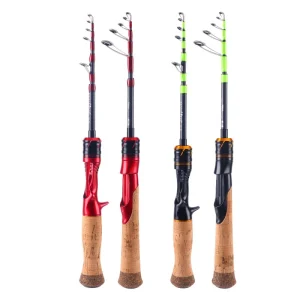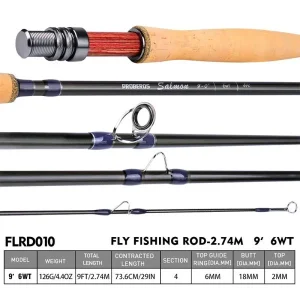
Creating a homemade fishing rod is a fun and exciting project for new fishers. Start by choosing a strong rod blank. Fiberglass is tough, while graphite helps you feel fish nibbles. Pick a cozy handle, like EVA foam for light comfort or cork for a keener sense. Ensure the reel seat is firm. Line up the guides straight for easy casting. Match the rod’s features to the fish you want and the place you’ll fish. Spinning rods are awesome for beginners. Assemble it step by step with glue, thread, and careful tools. You can adjust things like length, power, or materials like 40T carbon fiber to improve it. Keep it clean to make it last. Avoid errors like misaligned guides. Use Laike’s parts for great quality at a low cost. A homemade fishing rod lets you make it perfect and teaches you cool skills.
What Are the Key Elements of a Fishing Rod You Should Know Before Building One?
Building a homemade fishing rod saves cash and feels rewarding. First, learn how each part makes the rod work well and feel nice.
What Makes the Rod Blank the Backbone of Your Fishing Setup?
The rod blank is the main pole of your homemade fishing rod. It controls how the rod bends, how strong it is, and how it handles fish. Most blanks are fiberglass or graphite. Fiberglass is sturdy and cheap, great for newbies or tough spots. Graphite is lighter and lets you sense bites better, but it costs more and might snap more easily. Choose one that suits your needs.
Why Is Choosing the Right Handle Material Crucial for Comfort?
You’ll hold the rod for hours, so the handle must feel good. EVA foam grips are light and tough, a favorite for DIY builders. They’re soft, easy to clean, and last long. Cork grips help you feel bites more, but they wear out faster. Both are fine, but EVA is easier for beginners.
How Does the Reel Seat Influence Stability?
The reel seat holds your reel tightly to the rod blank. A good one keeps the rod balanced and your hand relaxed. When building, ensure it fits your reel type—spinning or casting—snugly. This prevents wobbling and makes fishing smoother.
Why Are Guides and Tip-Tops Essential for Line Control?
Guides direct the fishing line when you cast or reel. More guides spread the line’s weight, making the rod stronger. Pick stainless steel guides with ceramic centers. They reduce friction for smoother casts and longer throws. The tip top, at the rod’s end, must stay secure to keep the line steady.
What Type of Homemade Fishing Rod Should You Build?
The rod you make depends on the fish you chase and where you fish.
How Do Fish Species and Environment Affect Your Rod Choice?
For small lake fish like trout or panfish, a light spinning rod works well. For bigger fish like bass or catfish, or salty ocean water, a medium-heavy rod offers more strength and control. Think about your fishing spot and pick a rod that fits.
Which Rod Type Is Best for Beginners: Spinning, Casting, or Fly?

Spinning rods are the simplest for new fishers. They work with spinning reels and many lures without much practice. Casting rods need more skill, and fly rods are tricky for beginners. Choose a spinning rod for easy, fun fishing.
How Do You Build a Homemade Fishing Rod Step by Step?
Making a custom homemade fishing rod takes care, but beginners can do it with the right tools and steps.
What Tools Do You Need to Get Started?
You’ll need simple tools: epoxy glue, thread wrap finish, masking tape, a drying motor (optional), razor blades, a measuring tape, and quality parts from Laike. Tianjin Laike Co., Ltd has made fishing gear for over 10 years. Good tools make the job easier and the rod better.
How Do You Attach the Handle Correctly?
Begin by gluing an EVA foam grip to the rod blank’s bottom end. EVA is light, sturdy, and feels nice. It’s easy to clean and lasts long. Line it up straight with the rod’s spine, its strongest part. Use epoxy to stick it firmly.
How Should You Install Reel Seats and Guides Accurately?
If the reel seat feels loose, wrap masking tape around the blank to make it fit tightly. Then, apply epoxy to secure it. For guides, use a tool to align them straight. Crooked guides ruin casts, so take care to set them right.
What’s Involved in Wrapping Guides with Thread?
After setting guides on the blank, wrap them tightly with thread. A wrapping jig keeps it tidy. Next, brush a thin layer of epoxy over the thread to lock it in. This makes guides strong while letting the rod bend easily.
Can You Customize Your Homemade Rod for Better Performance?
Yes! Building your own homemade fishing rod lets you shape it to match your skills and fishing style.
How Can You Adjust Length or Power Based on Experience Level?
Short rods, around 5 to 7 feet, are easier to handle. They’re great for beginners or tight spaces like kayaks. Longer rods, 8 feet or more, cast farther but need more practice. Pick a length that suits your skill.
Why Upgrade Your Blank Material for Performance Gains?
Switching from fiberglass to carbon fiber blanks makes the rod lighter and sharper. Laike Fishing rods use carbon fiber, which is light, stiff, and strong. This helps you feel better and handle fish more easily.
How Should You Maintain Your Homemade Fishing Rod Long-Term?
Taking care of your rod keeps it working great for years, especially in fresh and salty water.
What’s the Best Way to Clean After Each Use?
Rinse your rod with fresh water after every trip. This is very important for saltwater to prevent rust on guides and reel seats. Dry it fully before storing to avoid damage.
How Can Regular Inspections Prevent Failures?
Check your rod often with a tackle maintenance kit. Look at guides, thread wraps, and epoxy for cracks or wear. Fixing small problems early keeps your rod ready for big fish fights.
Which Products Are Recommended for Beginners Building Their First Rods?
New builders should try beginner-friendly kits with all the parts you need:
- Laike Fiberglass Rod Blanks: Strong and flexible for many fishing types.
- Laike EVA Grips: Soft and sturdy for long fishing trips.
- Laike Stainless Steel Guides: Have ceramic centers for smooth line flow.
- Complete DIY Kits: Include everything for easy building with great quality.
What Mistakes Should You Avoid When Building a Homemade Fishing Rod?
Even experts can mess up if they’re not careful. Here’s what to avoid.
Why Is Proper Guide Alignment Non-Negotiable?
If guides aren’t straight, your line won’t cast well, and the rod might break. Always use tools to check alignment before wrapping them for good.
Why Should All Components Be Compatible With Each Other?
Using parts from random places can cause poor fits or breaks during fishing. Stick with trusted brands like Laike, where parts fit together perfectly.
Why Is Building Your Rod Using Laike Components Worth It?
Crafting a homemade fishing rod with Laike parts gives you more than a rod—it’s a fun learning experience.
Is It More Affordable Than Buying Retail Rods?
Yes! Getting blanks and parts from Laike avoids extra store costs. You get a high-quality rod for less money.
Can Customization Improve Your Catch Rate Over Time?
Definitely. A rod built for your fishing style—length, action, and power—helps you cast better and feel bites faster. This leads to more fish being caught.
Does DIY Enhance Your Overall Angling Skillset?
For sure! Building a rod teaches you to pay attention to details. You learn how parts affect casting, control, and fish-fighting, making you a better angler.
FAQ
Q1: Can I build a homemade fishing rod without prior experience?
A: Yes! Laike’s beginner kits include parts like grips, blanks, and guides, plus clear instructions. Even new fishers can build a great rod.
Q2: What’s better for handles: EVA foam or cork?
A: EVA foam lasts longer and is easier to clean. Cork senses bites better but wears out quicker. EVA is great for most beginners.
Q3: Are fiberglass blanks suitable for saltwater use?
A: Yes, fiberglass resists rust naturally. But rinse it well after saltwater trips to keep it in good shape.




